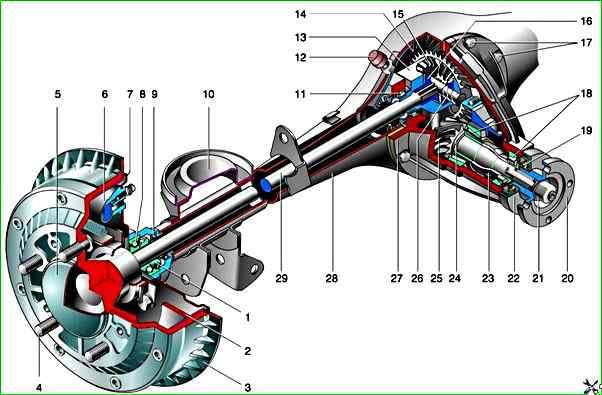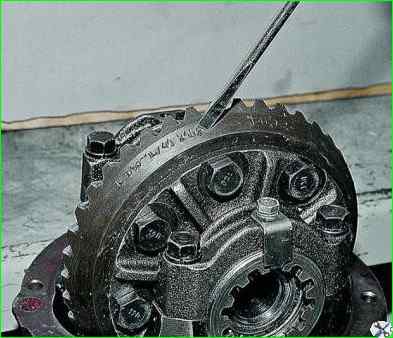The rear axle of the car is made in the form of a hollow beam, to the ends of which flanges with seats for axle shaft bearings and holes for mounting brake shields are welded.
In the middle, the main gear reducer with differential is bolted to the beam, and on the flange side, two axle shafts are inserted into the beam, transmitting torque from the reducer to the rear wheels.

Sectional view of the rear axle: 1 – bearing retaining ring; 2 - brake shoe; 3 - brake drum; 4 - wheel stud; 5 - wheel cap; 6 - brake cylinder; 7 - brake shield; 8 - axle shaft bearing; 9 - axle shaft oil seal; 10 - spring support cup; 11 - differential case bearing; 12 - breather; 13 - differential case; 14 - final drive driven gear; 15 - satellite; 16 - axle shaft gear; 17 - gearbox-to-rear axle beam mounting bolts; 18 - pinion gear bearings; 19 - pinion gear oil seal; 20 - flange; 21 - pinion gear nut; 22 - mud deflector ring; 23 - spacer sleeve; 24 - adjusting ring; 25 - pinion gear; 26 – satellite axle; 27 – gearbox housing; 28 – rear axle beam; 29 – axle shaft
The main gear is hypoid, its gears are selected for noise and contact, so they can only be replaced as an assembly (pair marking - 2106).

The driving gear of the main gear is made integral with the shaft (tailpiece) and is installed in the gearbox neck on two tapered bearings.
Outer bearing rings pressed into the neck sockets, and the inner ones are put on the tailpiece.
A spacer sleeve is installed between the inner rings; when tightening the tailpiece nut, the bushing is deformed, providing constant preload of the bearings.
The preload of the bearings is controlled by the torque of the drive gear (other parts are not installed).
For new bearings, the torque should be within 157-197 Nm, for bearings after a run of 30 km or more - 39.2-59.0 Nm.
In this case, the tailpiece nut is tightened with a torque of 118-255 Nm, periodically checking the rotation of the drive gear.
If the specified torque has already been reached, and the tightening force of the nut is less than 118 Nm, it is necessary to replace the spacer sleeve with a new one, since the old one is deformed too much.
Replacing the sleeve is also necessary if the torque is higher than the permissible value (due to carelessness when tightening).
If the main pair or the bearings of the drive gear are replaced, it is necessary to re-select the thickness of the adjusting ring.
It is installed on the shaft between the drive gear and the inner ring of the large bearing.
The driven gear of the main transmission is attached to the flange of the differential box with special bolts without washers.
These bolts cannot be replaced with any others.
The differential box rotates in two tapered bearings.
Their preload, as well as the gap between the teeth of the gears of the main transmission, is adjusted with nuts screwed into the split beds of the bearings.
The half-axle gears are installed in cylindrical sockets of the differential box and rest on it through thrust washers.
These washers are selected by thickness so that the gap between the teeth of the satellites and axle gears were within 0 - 0.1 mm.
The satellites are mounted on the axle with constant engagement with the axle gears.
The axle has spiral grooves for supplying lubricant to the rubbing surfaces.
One end of the axle shaft rests on a single-row ball bearing installed in the rear axle beam socket, and the other (splined) end enters the axle gear.
The inner ring of the bearing is fixed to the axle shaft with a locking ring installed with interference (shrink fit).
The outer ring of the bearing is fixed with a plate, which, together with the oil deflector and brake shield, is fastened with four bolts and nuts to the rear axle beam.
1.3 liters of transmission oil are poured into the rear axle housing (practically — to the lower edge of the filler hole).
The outputs of the axle shafts from the beam are sealed with oil seals.
If the oil seals are not tight, the oil is discharged through the oil deflector to the outside of the brake shield — this way it does not get on the brake pads.
The oil seal installed in the gearbox neck works on the flange surface.
An oil deflector is installed between the bearing and the flange.
Oil leakage from under the self-locking nut of the fastening flange (the same nut is used to adjust the bearing preload) indicates that it is loose.
Operating a vehicle with a loose gearbox nut may cause it to break.
A breather located on the rear axle beam above the gearbox serves to equalize the pressure outside and inside the rear axle housing.
Check that the breather cap is not jammed at each maintenance.
Checking the rear axle for serviceability
Check the tightness of all threaded connections and tighten them if necessary.
The breather cap must be clean of dirt and rotate freely.
Using your hands, apply a force of about 10 kgf along the axis of the suspended wheel and determine the presence of play in the axle shaft. It is allowed to be no more than 0.7 mm.
The parking brake must be released during this check.
A minor oil leak (sweating) from under the front bearing seal of the main gear is allowed, but if the gearbox and the bottom of the car above the main gear are heavily oiled, the seal should be replaced.
The noise in the rear axle and, accordingly, the need for repairs can be determined based on the results of the following tests.
Test 1
Smoothly accelerate the car on a level road from a speed of 20 to 90 km/h.
At the same time, listen to the noise and note the speed at which it appears and disappears.
Release the gas pedal and listen to the car in engine braking mode.
Usually the noise appears and disappears at the same the same speeds, both during acceleration and deceleration.
Test 2
Accelerate the car to a speed of 100 km/h, move the gearshift lever to neutral, turn off the ignition and roll freely to a stop.
At the same time, monitor the nature of the noise at various deceleration speeds.
In the first version, we tested the gearbox in acceleration and braking mode under the load created by the engine.
In the second - without it.
If the sound is present only during the first test, it can be caused by the gearbox gears, pinion bearings or differential.
If the noise appears in both cases, its source must be sought elsewhere.
Test 3
Set the gearbox lever to neutral, start the engine and gradually increase the crankshaft speed shaft.
Compare the noises that arise with those previously noticed.
If they are similar to the noises that arise during the first test, this indicates that they do not come from the gearbox.
Test 4
The noises detected during the first test and absent during subsequent tests are caused by the gearbox.
To confirm, lift the rear wheels, start the engine and engage fourth gear.
Make sure that the noises really come from the gearbox and not from other components or parts.





